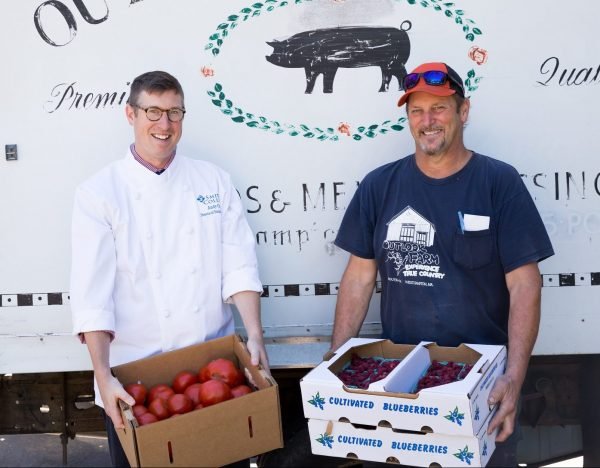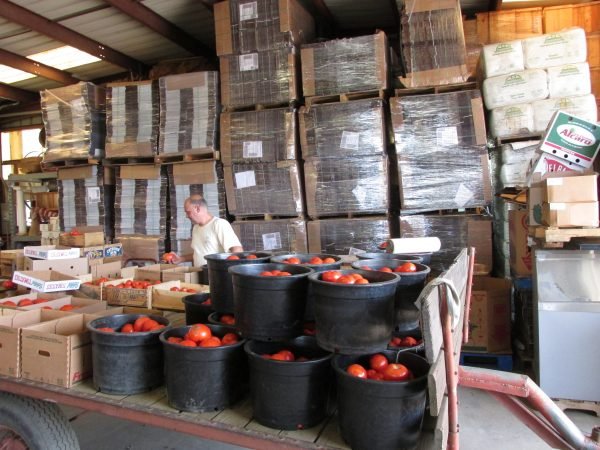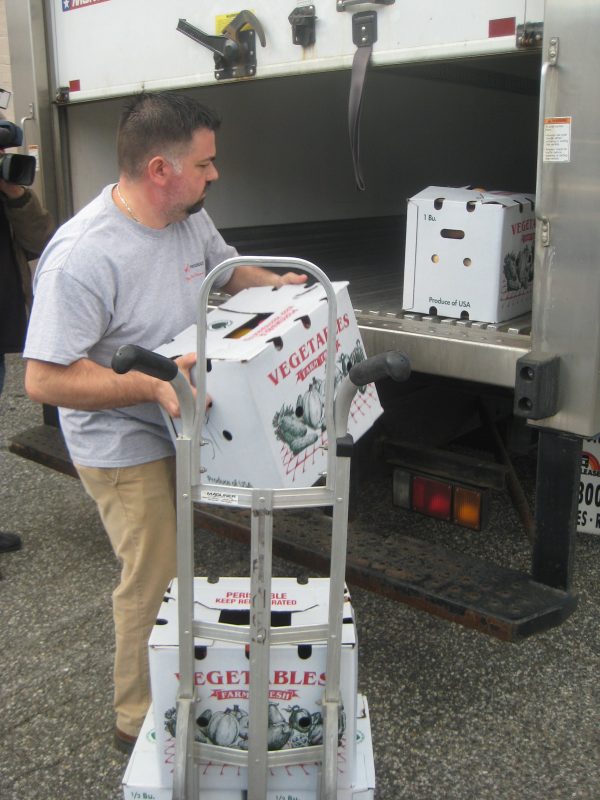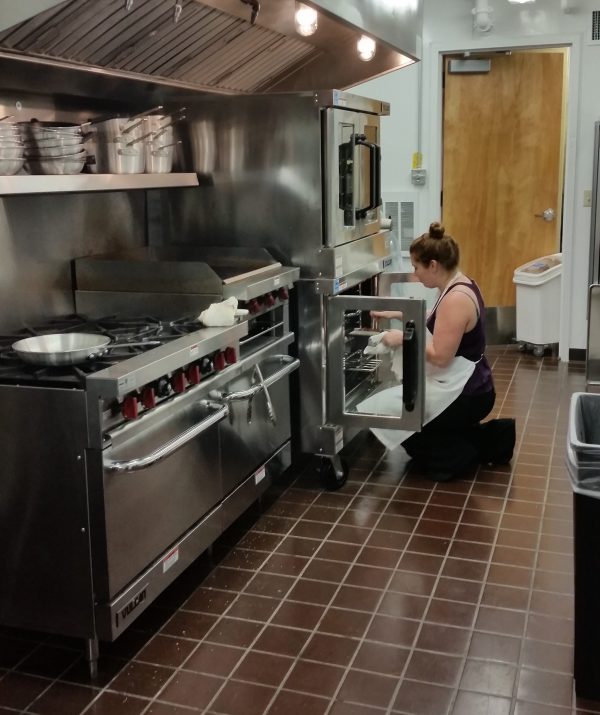Find It Locally
Search CISA’s online guide to local farms, food, and more!
Find Local Food
Andy Cox, Director of Dining Services at Smith College, and Brad Morse of Outlook Farm in Westhampton
A truly robust local food economy will supply great food to all the places we shop and eat: supermarkets and snack bars, college dining halls and school cafeterias, fine dining rooms and fast food outlets—as well as farm stands and farmers’ markets. Connecting local farms and larger buyers isn’t always easy, though. In 2016, CISA set out to understand the challenges and identify solutions to improve the wholesale marketplace for local food. We talked to a lot of people—more than 40 farmers, buyers, and distributors—and we’re using their input to improve the wholesale marketplace for farmers, support innovative chefs, buyers, and produce managers, and get good food to people all over our region.
Our interviews with farmers, buyers, distributors, and processors revealed a marketplace for locally grown produce that is both promising and fragile. It corroborated our understanding that demand from large buyers is increasing and represents a significant outlet for Massachusetts-grown produce. There was widespread agreement among farmers and buyers that the strong “buy local” campaign in western Massachusetts has expanded large-scale wholesale market opportunities for local produce. At the same time, local farms continue to be at a disadvantage when compared to the large industrialized farms that supply the bulk of these markets.
In many cases, the systems and relationships on which local produce sales are built remain dependent on particular individuals or businesses, and are not yet institutionalized in public policy or the private sector. In addition, prices have remained stagnant amidst increasing costs, threatening the continued profitability of these markets for local farms. Labor costs in particular have risen rapidly on local wholesale farms due to minimum wage increases and new regulatory and buyer requirements, such as those for food safety. These shifts favor large and heavily mechanized farms over smaller and more diversified farms. The small profit margins for local farms in these markets limit both farmer income and worker advancement, and none of the farmers we spoke with expressed confidence that their businesses could weather additional cost increases or lower prices.

Packing up tomatoes at E. Cecchi Farms in Feeding Hills
Total vegetable sales in the Pioneer Valley nearly doubled between 2002 and 2012, from roughly $24 million to about $46 million. During that same period, total direct sales for all farm products in the region only increased by about $5 million, indicating a significant increase in vegetable sales through wholesale channels. This suggests that wholesale produce markets continue to be a key growth area for local farms and represent new market opportunities.
Until the strong consumer preference for local produce translates into widespread pricing or marketing advantages for local farms, however, Massachusetts’ farmers remain vulnerable players in a global marketplace.
In this environment, greater financial and technical support is crucial in enabling farms to strategically evaluate and develop new markets as well as meet new buyer requirements. Support for distributors that primarily serve local farms can also help ensure that these key players in large-scale local produce markets are able to weather transitions and achieve the best prices possible for local products. A strong “buy local” effort is also needed to continue to build demand for local produce among a wider audience of consumers and large buyers. At the same time, in order to achieve true long-term sustainability and expansion of local wholesale produce markets, investment in the recommendations outlined in this report must be matched by efforts to shift federal agricultural policy in ways that support local food systems and family-scale farms.

Tony Calabrese of Calabrese Farms in Southwick loads up local produce for distribution by AC Produce in Springfield
The recommendations summarized below are those that are most amenable to local action that could benefit multiple players in the wholesale markets in our region
Suggestions for support needed to fill in gaps in wholesale markets
Provide technical and financial assistance to farms for food safety improvements. More technical and financial support is needed to help local farms plan and implement food safety improvements, as well as learn how to efficiently fit new tasks into farm workflows.
Help buyers identify the “sweet spots” in purchasing local produce. Offer personalized technical assistance to help buyers pinpoint the opportunities to expand local purchasing that best meet their needs, fit within budgetary constraints, and have the most impact in supporting local farms.
Offer assistance to distributors that have a central mission of supporting local farms. Support given to these businesses – e.g. to facilitate business transitions, strengthen communication with stakeholders, update infrastructure, or help improve profitability – would benefit many farms.
Continue to expand the “buy local” campaign. The most common advice given by farmers and buyers on how to strengthen large-scale wholesale markets for local food was to expand efforts to educate the community about the benefits of buying from local farms.
Provide support for local sourcing and market development for farmers and buyers. Both growers and buyers can benefit from support from organizations that are in active communication with a range of farmers and buyers, which can help identify current market opportunities and prepare for possible future trends.
Assist farms with in-depth business analysis. There is an unmet need for in-depth, individualized support to help farms analyze their finances, evaluate current enterprises, assess opportunities, and strategically plan for the future.
Suggestions for buyers to help expand local food purchasing
Offer flexibility in requirements for local farms. Adopting scale-appropriate supplier requirements can help buyers ensure that local farms are able to compete with other vendors in supplying their needs.
Prioritize investments in local produce that offer a larger “bang for the buck.” It often makes sense for buyers to start by working with farms and local crops that are more price-competitive with non-local produce and suppliers. Buyers should see these products and relationships as a platform from which to expand their local sourcing, rather than reaching an early and final plateau.
Offer support to farmers for up-front costs like online ordering fees and food safety certifications. When farmers must incur up-front costs to sell to a buyer, buyers can help ensure that small local farms are not disadvantaged by sharing in such costs or guaranteeing future order volumes and pricing.
Offer greater transparency regarding rebates or “volume discount allowances.” Foodservice management companies should offer full transparency to their clients regarding the amounts of the rebates they are given for high-volume purchases so as to improve their client’s ability to understand the actual costs of food purchases and work in cooperation with them to manage budgetary costs of local food purchases.

Dining Services kitchen at Hampshire College
Offer training to increase staff capacity to prepare local food, and seek staff input. Maintaining open lines of communication with kitchen staff and using the transition to more locally grown, less processed food as an opportunity for professional development and increased chef creativity is important for getting staff buy-in regarding changes.
Consider foodservice management changes to expand local produce use. Local purchasing is hindered if foodservice managers and their clients do not hold shared local sourcing goals. Clients should clearly discuss their goals with foodservice managers to assess opportunities and limits to achieving them.
Consider structural changes in dining services that support using local produce. Increased storage and washing space and more centralized kitchen and dining facilities can increase efficiency of processing fresh produce and result in budgetary savings that can be invested in local produce.
Promote local farm suppliers to customers. Demand from end-users is a critical driver of local sourcing, and educating those end-users about local farm suppliers helps to build momentum for local purchasing that can institutionalize local purchasing patterns.
Maintain in-house labeling or packaging capacity for local farm produce in retail settings. Having the ability to label or wrap individual produce items in-house can enable smaller farms to sell to retail buyers without being unfairly disadvantaged by having to invest in expensive equipment.
In late 2015 and 2016, 42 farmers, buyers, and partners from 35 businesses and organizations provided input for this study through interviews, panels, and focus groups. This included 16 farmers from 12 farms, 22 buyers from 17 businesses, and four partners with expertise in large-scale wholesale produce markets. Participating buyers included ten distributors, five schools, three retailers, and one restaurant. In addition to these in-depth interactions, we held a discussion with 33 wholesale growers and buyers early in the process and surveyed CISA’s Local Hero business members.
This study was made possible with support from the USDA Rural Development Business Enterprise Grant program and the USDA Sustainable Agriculture Research and Education Program.
For more information, contact Kristen Wilmer, Program Coordinator, or call (413) 665-7100.